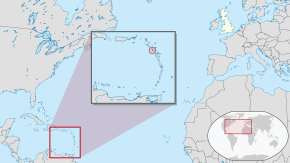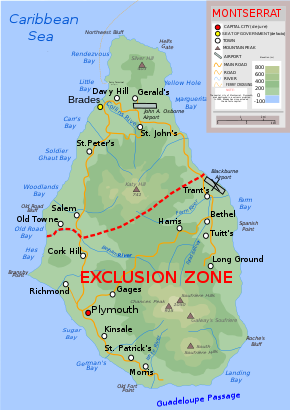
Back Montserrat Afrikaans Montserrat ALS ሞንትሠራት Amharic Isla de Montserrat AN Muntserræt ANG माँटसेराट ANP مونتسرات Arabic مونتسيرات ARZ Montserrat AST Montserrat Azerbaijani
Montserrat | |
|---|---|
| Motto: "A people of excellence, moulded by nature, nurtured by God" | |
| Anthem: "God Save the King" | |
| National song: "Motherland" | |
 Location of Montserrat (circled in red) | |
 Topographic map of Montserrat showing the "exclusion zone" due to volcanic activity, and the new airport in the north. The roads and settlements in the exclusion zone have mostly been conquered by natural forces. | |
| Sovereign state | |
| English settlement | 1632 |
| Treaty of Paris | 3 September 1783 |
| Federation | 3 January 1958 |
| Separate colony | 31 May 1962 |
| Capital | Plymouth (de jure)[a] Brades (de facto)[b] Little Bay (under construction) 16°45′N 62°12′W / 16.750°N 62.200°W |
| Largest city | Brades |
| Official languages | English |
| Demonym(s) | Montserratian |
| Government | Parliamentary dependency under a constitutional monarchy |
• Monarch | Charles III |
• Governor | Sarah Tucker[1] |
• Premier | Reuben Meade |
| Legislature | Legislative Assembly |
| Government of the United Kingdom | |
• Minister | Stephen Doughty |
| Area | |
• Total | 102 km2 (39 sq mi) |
• Water (%) | negligible |
| Highest elevation | 1,050 m (3,440 ft) |
| Population | |
• 2022 estimate | 4,390[2] (194th) |
• 2018 census | 4,649[3] (intercensal count) |
• Density | 46/km2 (119.1/sq mi) (not ranked) |
| GDP (PPP) | 2014 estimate |
• Total | US$63 million[4] |
• Per capita | US$12,384 |
| GDP (nominal) | 2019 estimate |
• Total | US$181,680,000[5] |
| Currency | East Caribbean dollar (XCD) |
| Time zone | UTC-4:00 (AST) |
| Driving side | Left |
| ISO 3166 code | MS |
| Internet TLD | .ms |
| Website | https://www.gov.ms/ |
Montserrat (/ˌmɒntsəˈræt/ MONT-sə-RAT, locally /ˈmɒntsəræt/[6]) is a British Overseas Territory in the Caribbean. It is part of the Leeward Islands, the northern portion of the Lesser Antilles chain of the West Indies. Montserrat is about 16 km (10 mi) long and 11 km (7 mi) wide, with roughly 40 km (25 mi) of coastline.[7] It is nicknamed "The Emerald Isle of the Caribbean" both for its resemblance to coastal Ireland and for the Irish ancestry of many of its inhabitants.[8][9] Montserrat is the only non-fully sovereign full member of the Caribbean Community and the Organisation of Eastern Caribbean States, though it is far from being the only dependency in the Caribbean overall.
On 18 July 1995, the previously dormant Soufrière Hills volcano in the southern end of the island became active and its eruptions destroyed Plymouth, Montserrat's Georgian era capital city situated on the west coast. Between 1995 and 2000, two-thirds of the island's population was forced to flee, mostly to the United Kingdom, leaving fewer than 1,200 people on the island in 1997. (The population had increased to nearly 5,000 by 2016).[10][11] The volcanic activity continues, mostly affecting the vicinity of Plymouth, including its docks, and the eastern side of the island around the former W. H. Bramble Airport, the remnants of which were buried by flows from further volcanic activity on 11 February 2010.
An exclusion zone was imposed, encompassing the southern part of the island as far north as parts of the Belham Valley, because of the size of the existing volcanic dome and the resulting possibility of pyroclastic activity. Visitors are generally not permitted to enter the exclusion zone, but a view of destroyed Plymouth can be seen from the top of Garibaldi Hill in Isles Bay. The volcano has been relatively quiet since early 2010 and continues to be closely monitored by the Montserrat Volcano Observatory.[12][13]
In 2015, it was announced that planning would begin on a new town and port at Little Bay on the northwest coast of the island, and the centre of government and businesses was moved temporarily to Brades.[14] After a number of delays, including Hurricanes Irma and Maria in 2017[15] and the COVID-19 pandemic beginning in early 2020,[16] the Little Bay Port Development Project, a £28 million project funded by the UK and the Caribbean Development Bank, began in June 2022.
Cite error: There are <ref group=lower-alpha> tags or {{efn}} templates on this page, but the references will not show without a {{reflist|group=lower-alpha}} template or {{notelist}} template (see the help page).
- ^ "Change of Governor of Montserrat: Sarah Tucker". Gov.uk. 8 December 2021. Archived from the original on 12 March 2022. Retrieved 19 March 2022.
- ^ "World Population Prospects 2022". population.un.org. United Nations. 2022. Archived from the original on 16 August 2015. Retrieved 25 June 2023.
- ^ "Intercensal Population Count and Labour Force Survey 2018" (PDF). Montserrat Statistics Department Labour Force Census Results. Montserrat Statistics Department. 6 December 2019. Archived (PDF) from the original on 14 November 2019. Retrieved 14 November 2019.
- ^ "UN Data". 2014. Archived from the original on 30 December 2016. Retrieved 8 January 2017.
- ^ "Montserrat Real Gross Domestic Product | Moody's Analytics". economy.com. Archived from the original on 10 August 2021. Retrieved 9 August 2021.
- ^ Wells, John C. (2008). Longman Pronunciation Dictionary (3rd ed.). Longman. ISBN 978-1-4058-8118-0.
- ^ Cite error: The named reference
cia.govwas invoked but never defined (see the help page). - ^ "The Caribbean Irish: the other Emerald Isle". The Irish Times. 16 April 2016. Archived from the original on 16 April 2016. Retrieved 9 January 2018.
- ^ "► VIDEO: Montserrat, the Emerald Isle of the Caribbean". The Irish Times. Archived from the original on 28 June 2023. Retrieved 9 January 2018.
- ^ "Montserrat Volcano Observatory". Mvo.ms. Archived from the original on 2 October 2006. Retrieved 2 October 2006.
- ^ Cite error: The named reference
2016Popwas invoked but never defined (see the help page). - ^ Bachelor, Blane (20 February 2014). "Montserrat: a modern-day Pompeii in the Caribbean". Fox News Channel. Archived from the original on 30 June 2023. Retrieved 16 March 2016.
- ^ Pilley, Kevin (29 February 2016). "Bar/fly: Caribbean island of Montserrat". The New Zealand Herald. Archived from the original on 28 June 2023. Retrieved 30 November 2016.
- ^ Handy, Gemma (16 August 2015). "Montserrat: Living with a volcano". BBC News. Archived from the original on 8 August 2017. Retrieved 8 July 2017.
- ^ "Hurricanes Irma and Maria: government response and advice". GOV.UK. 27 September 2017. Archived from the original on 2 July 2022. Retrieved 1 July 2022.
- ^ "UK Armed Forces step up support to the Caribbean Overseas Territories during coronavirus pandemic". GOV.UK. Archived from the original on 2 July 2022. Retrieved 1 July 2022.

